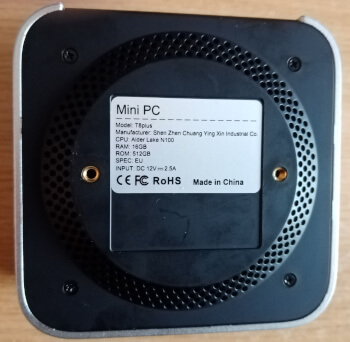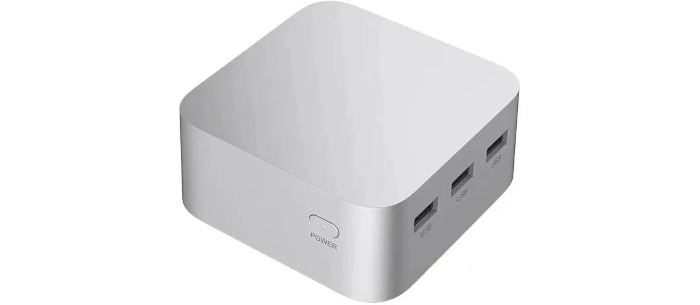This is a multi-part blog looking at a FIREBAT T8 Plus Mini PC running Linux. This machine has an Intel N100 processor, 16GB of RAM, 512GB M.2 SSD and is available for under £100. It sounds like an ideal low cost machine to run Linux. This series will examine every aspect of this Mini PC in detail from a Linux perspective. We’ll compare the machine with other ultra small form factor PCs along the way.
The Mini PC was supplied by a retailer on AliExpress and shipped from China to the UK in only 5 days (beating the estimated 7 day delivery time). The Mini PC cost £108 which is inclusive of 20% VAT. Shipping is free, and no customs duty is payable in the UK as the value of the consignment is under £135. We recommend PayPal as it’s arguably the safest method of payment when dealing with overseas transactions. The price has subsequently fallen to under £90.
At the heart of the FIREBAT is the Intel N100, a processor which has 4 cores, 4 threads (i.e. there’s no hyperthreading), and a maximum turbo frequency of 3.40 GHz. It’s an interesting CPU in part because it offers Skylake performance at a fraction of the power, it can take DDR5 RAM, and can drive three 4K displays at 60Hz refresh rate.
The machine is paired with a 512GB M.2 SSD and 16GB of DDR5 RAM. The SSD is replaceable but that is not the case for the RAM which cannot be replaced or upgraded. Fortunately 16GB of RAM is more than sufficient for many home users.
The machine comes with a Windows 11 Pro digital license. But apart from briefly testing it under Windows and benchmarking the disk, we swiftly replaced Windows with Ubuntu 23.10. Also bear in mind it appears to be a custom install of Windows 11, so we’d suggest a clean install if say you want to dual boot with Linux.
Design
One of the most challenging parts of having a traditional desktop setup is finding space for the base unit, the monitor, and all the wired/wireless extras. Mini PCs take up minimal space. Some can be mounted at the back of a monitor, others will fit on even the smallest desks.
The diminutive FIREBAT has dimensions of 89.4mm x 89.4mm x 43.5mm. It comes with a mounting bracket to attach the machine to the back of a monitor. Other advantages of its diminutive size are portability, its lightweight, and fits the aesthetic appeal of even the most minimalist designer. It’s housed in a grey plastic case with a label on the bottom. No branding on the case itself is unusual.
A major disadvantage of many Mini PCs is their limited expansion capability. Their small size often means that the machine cannot be upgraded or the options are very limited.
On the right hand side reside three USB 3.1 Type-A ports. The other side has 3 HDMI ports. At the rear are 2 RJ45 1GbE ethernet ports. There’s also an audio jack.
The Mini PC is only available with an EU plug. Fortunately, we had a spare European to UK plug adapter to hand. At first glance, the ports are a mite disappointing. For example, there’s no USB-C, and 3 USB ports is a bit limiting. But two ethernet ports may be useful in some situations even though we’d preferred a 2.5Gb LAN port. On balance the range of ports is good for such an inexpensive machine.
 The actual design of the case gets a thumbs up. There are lots of ventilation slots to help keep the innards cool both at the bottom and rear of the case.
The actual design of the case gets a thumbs up. There are lots of ventilation slots to help keep the innards cool both at the bottom and rear of the case.
It’s a cheap plastic case, but this is a reasonable way to keep the cost down.
Is the Mini PC quiet? Absolutely. If you put your head right near the device you’ll hear a faint hum even when the machine is idle. But from 1 metre away, the machine’s fan is inaudible. And the best thing is that when the machine is under full load, the fan noise is still extremely quiet. It’s much quieter than the NUC 13 Pro Mini PC when that’s under load.
On the next page we use the inxi utility to drill down in more detail.
Next page: Page 2 – Specifications
Pages in this article:
Page 1 – Introduction
Page 2 – Specifications
Complete list of articles in this series:
| FIREBAT T8 Plus Mini PC | |
|---|---|
| Part 1 | Introduction to the series with an interrogation of the system |
| Part 2 | Benchmarking the FIREBAT T8 Plus Mini PC |
| Part 3 | Testing the power consumption |
| Part 4 | Multimedia: Watching videos and listening to music |
| Part 5 | How does the FIREBAT fare as a gaming PC? |
| Part 6 | Windows Subsystem for Linux 2 |
| Part 7 | Installing and Configuring EndeavourOS, an Arch-based distro |
| Part 8 | Installing and Configuring Rhino Linux, a rolling release Ubuntu-based distro |
| Part 9 | VirtualBox performance on the FIREBAT |

Can you show what the SSD gets in CrystalDiskMark please?
Here you go Alan.
These articles about Mini-PCs are really interesting, thanks!